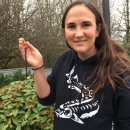The last bull trout Salvelinus confluentus documented in the Clackamas River was in 1963. Over 40 years later, a 2007 feasibility study suggested the Clackamas River Subbasin could support bull trout and would be a good reintroduction candidate. A reintroduction effort was first implemented in 2011, with the goal of establishing a naturally reproducing population of spawning adults (between 300 and 500) by the year 2030. In 2016, we continued bull trout reintroduction efforts by collecting and transferring 595 juveniles, 94 subadults, and 6 adults from the Metolius River Subbasin to designated locations in the upper Clackamas River. Monitoring and evaluation efforts were conducted to assess the effectiveness of the reintroduction strategy by describing the seasonal distribution of translocated bull trout, assessing reproduction, and characterizing potential impacts to Endangered Species Act-listed salmon and steelhead that currently occupy the Clackamas River Subbasin. The sixth year of the project marks the end of the first phase of the reintroduction effort. Progress has continued to be made toward reaching the project’s goal. Individuals from each translocated life stage have survived, appear to be thriving, and are recruiting into the adult population. The number of adult translocated bull trout using Pinhead Creek during the spawning season has noticeably increased from 15 adults in 2013 to 72 in 2016, and redd counts throughout the study area are at their highest (N = 68) since the initiation of the reintroduction effort. However, there continue to be notable data gaps. Despite multiple years of documented spawning behavior, monitoring efforts have not produced evidence of successful natural reproduction and more robust evaluations of the impacts to listed salmon and steelhead both inside and outside the High Vulnerability Zones are lacking. Implementation and monitoring of the reintroduction project will continue to be evaluated on an annual basis and the reintroduction strategy will be adaptively managed.
Publication date
Type of document
Report
Facility
Program
Species
FWS Focus
Ecosystem
FWS and DOI Region(s)






